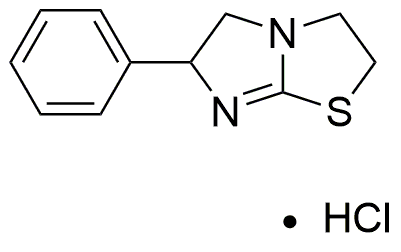Tetramisole hydrochloride is widely utilized in research focused on:
- Veterinary Medicine: Commonly used as an anthelmintic agent to treat parasitic infections in livestock, improving animal health and productivity.
- Pharmaceutical Development: Investigated for its immunomodulatory properties, it has potential applications in developing treatments for autoimmune diseases.
- Research on Cancer: Studies indicate that it may enhance the effectiveness of certain chemotherapy drugs, providing a complementary approach in cancer treatment.
- Agricultural Applications: Employed in crop protection as a pesticide, helping to manage nematode infestations and improve crop yields.
- Analytical Chemistry: Used in various assays to detect and quantify specific compounds, aiding researchers in environmental and food safety studies.
Información general
Propiedades
Seguridad y normativas
Aplicaciones
Tetramisole hydrochloride is widely utilized in research focused on:
- Veterinary Medicine: Commonly used as an anthelmintic agent to treat parasitic infections in livestock, improving animal health and productivity.
- Pharmaceutical Development: Investigated for its immunomodulatory properties, it has potential applications in developing treatments for autoimmune diseases.
- Research on Cancer: Studies indicate that it may enhance the effectiveness of certain chemotherapy drugs, providing a complementary approach in cancer treatment.
- Agricultural Applications: Employed in crop protection as a pesticide, helping to manage nematode infestations and improve crop yields.
- Analytical Chemistry: Used in various assays to detect and quantify specific compounds, aiding researchers in environmental and food safety studies.
Documentos
Hojas de datos de seguridad (HDS)
La SDS proporciona información de seguridad completa sobre la manipulación, el almacenamiento y la eliminación del producto.
Especificación del producto (PS)
La PS proporciona un desglose completo de las propiedades del producto, incluida la composición química, el estado físico, la pureza y los requisitos de almacenamiento. También detalla los rangos de calidad aceptables y las aplicaciones previstas del producto.
Certificados de análisis (COA)
Busque certificados de análisis (COA) ingresando el número de lote del producto. Los números de lote y de partida se pueden encontrar en la etiqueta de un producto después de las palabras "Lote" o "Lote".
Número de catálogo
Número de lote/lote
Certificados de origen (COO)
Este certificado de origen confirma el país en el que se fabricó el producto y también detalla los materiales y componentes utilizados en él y si se deriva de fuentes naturales, sintéticas u otras fuentes específicas. Este certificado puede ser necesario para cumplir con las normativas aduaneras, comerciales y regulatorias.
Número de catálogo
Número de lote/lote
Hojas de datos de seguridad (HDS)
La SDS proporciona información de seguridad completa sobre la manipulación, el almacenamiento y la eliminación del producto.
DownloadEspecificación del producto (PS)
La PS proporciona un desglose completo de las propiedades del producto, incluida la composición química, el estado físico, la pureza y los requisitos de almacenamiento. También detalla los rangos de calidad aceptables y las aplicaciones previstas del producto.
DownloadCertificados de análisis (COA)
Busque certificados de análisis (COA) ingresando el número de lote del producto. Los números de lote y de partida se pueden encontrar en la etiqueta de un producto después de las palabras "Lote" o "Lote".
Número de catálogo
Número de lote/lote
Certificados de origen (COO)
Este certificado de origen confirma el país en el que se fabricó el producto y también detalla los materiales y componentes utilizados en él y si se deriva de fuentes naturales, sintéticas u otras fuentes específicas. Este certificado puede ser necesario para cumplir con las normativas aduaneras, comerciales y regulatorias.


